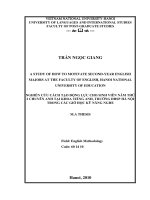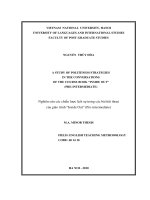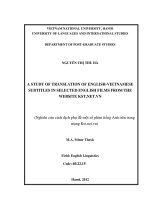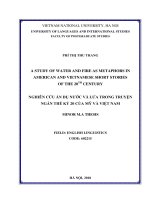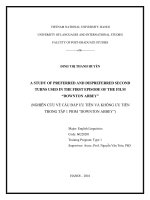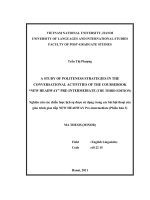Luận văn thạc sĩ a study of the effects of teaching grammar in ngo may secondary school based on deductive approach versus inductive approach
Bạn đang xem bản rút gọn của tài liệu. Xem và tải ngay bản đầy đủ của tài liệu tại đây (7.09 MB, 143 trang )
MINISTRY OF EDUCATION AND TRAINING
QUY NHON UNIVERSITY
NGUYEN VO BICH THUY
A STUDY OF THE EFFECTS OF TEACHING
GRAMMAR IN NGO MAY SECONDARY SCHOOL
BASED ON DEDUCTIVE APPROACH
VERSUS INDUCTIVE APPROACH
Field: Theory and Methodology of English Language Teaching
Code: 8140111
Supervisor: Truong Van Dinh, Ph.D.
BỘ GIÁO DỤC VÀ ĐÀO TẠO
TRƢỜNG ĐẠI HỌC QUY NHƠN
NGUYEN VO BICH THUY
NGHIÊN CỨU VỀ HIỆU QUẢ CỦA VIỆC SỬ DỤNG
PHƢƠNG PHÁP DIỄN DỊCH VÀ PHƢƠNG PHÁP QUY NẠP
TRONG VIỆC GIẢNG DẠY NGỮ PHÁP TẠI
TRƢỜNG THCS NGÔ MÂY
Ngành: Lý luận và phƣơng pháp dạy học bộ môn tiếng Anh
Mã số:
8140111
Ngƣời hƣớng dẫn: TS. TRƢƠNG VĂN ĐỊNH
i
DECLARATION OF AUTHORSHIP
The thesis entitled “A Study of the Effects of Teaching Grammar based on
Deductive Approach versus Inductive Approach” is conducted under the
supervision of Ph.D. Truong Van Dinh, a lecturer working at Quy Nhon
University.
I declare that the information reported in this study is the result of my own
work and effort, except where due reference is made. The thesis has not been
accepted for any degree and is not simultaneously submitted to any
candidature for any degree or diploma.
Binh Dinh, August 2022
Nguyen Vo Bich Thuy
ii
ACKNOWLEDGMENTS
Without the support, encouragement, and contributions from my Ph.D.
Truong Van Dinh, colleagues, friends and family, the successful completion
of this study work would not have been possible. I take this chance to
appreciate them for their useful advice and invaluable comments, and time.
They have always been by my side and helped me enriched my knowledge
and made my master thesis graduate journey a memorable chapter in my life.
First and foremost, I am grateful to my supervisor, Ph.D. Truong Van
Dinh, for his amazing supervision. His knowledge and profession teachingrelated expertise inspired me greatly during my studying at Quy Nhon
University, and he opened new horizons for me in every field. I profoundly
appreciate his accommodating guidelines and suggestions, great patience, and
strong management skills in helping me resolve the obstacles whenever I had
difficulties in my thesis. I am very lucky to have had him support me for my
work.
This study was made achievable by the presence of the enthusiastic
students at Ngo May Secondary School in Quy Nhon City, who devoted their
time taking part in this study. I was also thankful to my colleagues for their
fascinating assistance, encouragement and management during this phase. I
feel fortunate to know all of them.
Last but not least, I am grateful to all the support that I received from
my beloved parents throughout my thesis education.
iii
ABSTRACT
The present research seeks to investigate the effectiveness of English
grammar teaching to language users in EFL classrooms. In Vietnam, English
in general and grammar in particular has been taught deductively or
inductively depending on students’ needs, interests, attitudes and motivation.
To be more precise, the study has explored the effectiveness towards
inductive and deductive approaches to English grammar teaching held by 135
students in Ngo May Secondary School. The instruments for data collection to
serve the aim of the study are a survey questionnaire, a proficiency test and an
achievement test. Moreover, the objective of this research is to get empirical
data of the differences between students’ scores on grammar tests who were
taught inductively and deductively.
The research method used in this research was a quantitative method
using quasi-experimental design. The data was collected through pre-test and
post-test. After a careful long time of collecting and analyzing the data, it is
revealed in the research that the students’ performances in deductive class is
better than the inductive one despite the students’ improvement of grammar
retention.
Additionally,
through
the
different
instruments
such
as
questionnaires for students, class observation the underlying reasons for the
above problems have been revealed. Last but not least, the researcher also
offers some pedagogical suggestions that emerged from the research findings
with the hope to bring about some changes and progresses in English
grammar teaching for the sake of effective grammar learning on the students’
learning process.
iv
TABLE OF CONTENTS
DECLARATION OF AUTHORSHIP ......................................................................... i
ACKNOWLEDGMENTS...........................................................................................ii
ABSTRACT .............................................................................................................. iii
TABLE OF CONTENTS ........................................................................................... iv
LIST OF TABLES ....................................................................................................vii
LIST OF FIGURES.................................................................................................... ix
LIST OF ABBREVIATION ....................................................................................... x
CHAPTER 1. INTRODUCTION ............................................................................... 1
1.1. Rationale .......................................................................................................... 1
1.2. Aim and Objectives ......................................................................................... 5
1.2.1. Aim of the Study .................................................................................... 5
1.2.2. Objectives of the Study .......................................................................... 5
1.3. Research Questions .......................................................................................... 5
1.4. Scope of the Study ........................................................................................... 5
1.5. Significance of the Study ................................................................................. 6
1.6. Structure of the Thesis ..................................................................................... 6
CHAPTER 2. THEORETICAL BACKGROUND AND LITERATURE REVIEW . 8
2.1. Importance of Grammar in Teaching Foreign Languages............................... 8
2.1.1. Definition of Grammar........................................................................... 8
2.1.2. Types of Grammar ............................................................................... 11
2.2. Theories of Language Learning ..................................................................... 15
2.2.1. Krashen’s viewpoint regarding the role of grammar ........................... 18
2.2.2. Monitor Hypothesis.............................................................................. 19
2.2.3. Role of grammar in EFL contexts ........................................................ 20
2.3. Approaches to Grammar Teaching ................................................................ 21
2.3.1. Learning Grammar ............................................................................... 21
2.3.2. Two main approaches to Grammar Teaching ...................................... 21
2.3.3. Previous studies on Deductive versus Inductive Grammar Learning .. 28
2.3.4. Researches into effectiveness of Inductive and Deductive teaching ... 33
v
2.4. The knowledge gap in the literature .............................................................. 34
CHAPTER 3. METHODOLOGY ............................................................................ 36
3.1. Research Design ............................................................................................ 36
3.2. Variables ........................................................................................................ 37
3.3. Research Entrance Test .................................................................................. 38
3.4. Research Setting and Participants .................................................................. 39
3.4.1. Research Setting ................................................................................... 39
3.4.2. Participants ........................................................................................... 39
3.5. Quasi-experiment ........................................................................................... 40
3.6. Research Instruments ..................................................................................... 41
3.6.1. Pre-post test .......................................................................................... 41
3.6.2. Questionnaire ....................................................................................... 45
3.7. Procedures of the Study ................................................................................. 46
CHAPTER 4. FINDINGS AND DISCUSSION....................................................... 49
4.1. Description of Data ........................................................................................ 49
4.2. Pre-post-tests .................................................................................................. 49
4.2.1. Pre-test Scores ...................................................................................... 50
4.2.2. Treatment ............................................................................................. 58
4.2.3. Post-test Scores .................................................................................... 60
4.3. Effective Approach in Teaching Grammar.................................................... 67
4.4. Results of questionnaire ................................................................................. 71
4.4.1. Learning the grammatical rules helps me produce grammatically
correct sentences ............................................................................................ 73
4.4.2. I believe that I can improve my grammatical accuracy through practice
of grammatical structures ............................................................................... 74
4.4.3. Sometimes I have difficulties in producing language in a natural
conversation because I focus largely on correct use of grammar .................. 76
4.4.4. I need to know the structural pattern and its function before I can use it
proficiently ..................................................................................................... 77
4.4.5. I expect my teacher to present and explain grammatical points .......... 79
4.4.6. Learning grammatical rules is very useful for me ............................... 80
vi
4.4.7. I feel insecure when the teacher does not explain the grammatical rules81
4.5. Conclusion ..................................................................................................... 82
CHAPTER 5. CONCLUSION AND IMPLICATIONS ........................................... 84
5.1. Summary of the Study ................................................................................... 84
5.2. Significance of the findings ........................................................................... 88
5.3. Teaching implications .................................................................................... 89
5.3.1. Implication for EFL teachers ............................................................... 89
5.3.2. Implication for different types of learners ........................................... 90
5.4. Limitations and Suggestions for Further Research ........................................ 90
5.4.1. Limitations of Deductive Approach ..................................................... 91
5.4.2. Limitations of Inductive Approach ...................................................... 91
5.4.3. Suggestions for further research .......................................................... 91
REFERENCES .......................................................................................................... 93
APPENDICES
vii
LIST OF TABLES
Table 2.1. The Advantages and Disadvantages of Deductive Approach
(Widodo, 2006) ........................................................................................ 24
Table 2.2. The Advantages and Disadvantages of Inductive Approach (Widodo,
2006) ......................................................................................................... 26
Table 2.3. The relationship between two types of grammar instruction
(Krashen, 1993)........................................................................................ 19
Table 3.1. Means of classes in Ngo May Secondary School ................................... 38
Table 3.2. Number of participants .............................................................................. 40
Table 3.3. The Reliability of the Pre-post Tests ........................................................ 44
Table 3.4. The Reliability of Questionnaire .............................................................. 46
Table 3.5. Conversion of the Actual Score into a Five Scale Score........................ 48
Table 4.1. Group statistics of pre-test results of Experimental and
Control Group .......................................................................................... 51
Table 4.2. Difference of Level between Inductive class and Deductive class
before Intervention................................................................................... 53
Table 4.3. Group statistics of pre-test results of Experimental Group .................... 53
Table 4.4. Independent samples T-test of the Inductive and Deductive Classes
before the treatment ................................................................................. 54
Table 4.5. The percentage of frequency Pre-test score of Deductive class ............ 55
Table 4.6. The percentage of frequency Pre-test score of Inductive class .............. 56
Table 4.7. The percentage of frequency Pre-test score of Control Group .............. 57
Table 4.8. Group statistics of Post-test result of Experimental and
Control Group .......................................................................................... 61
Table 4.9. Group statistics of Post-test result of Experimental Group .................... 62
Table 4.10. Independent samples T-test of the Inductive and Deductive Classes
after the treatment .................................................................................... 63
Table 4.11. The percentage of frequency Post-test score of Deductive class......... 64
viii
Table 4.12. The percentage of frequency Post-test score of Inductive class .......... 65
Table 4.13. The percentage of frequency Post-test score of Control Group .......... 66
Table 4.14. Descriptive statistics of Post-test in Control Group and
Experimental Group ................................................................................ 67
Table 4.15. The comparison of mean of Pre-test and Post-test in Control Group
and Experimental Group ......................................................................... 68
Table 4.16. Descriptive statistics of Post-test in Inductive Class and Deductive
Class .......................................................................................................... 69
Table 4.17. The comparison of mean of Pre-test and Post-test in Experimental
Group ........................................................................................................ 69
Table 4.18. The reliability statistics of Questionnaire .............................................. 72
Table 4.19. Learning the grammatical rules helps me produce grammatically
correct sentences ...................................................................................... 74
Table 4.20. I believe that I can improve my grammatical accuracy
through practice of grammatical structures ........................................... 75
Table 4.21. Sometimes I have difficulties in producing language in a natural
conversation because I focus largely on correct use of grammar ....... 77
Table 4.22. I need to know the structural pattern and its function
before I can use it proficiently ................................................................ 78
Table 4.23. I expect my teacher to present and explain grammatical points .......... 79
Table 4.24. Learning grammatical rules is very useful for me ................................ 81
Table 4.25. I feel insecure when the teacher does not explain the grammatical
rules ........................................................................................................... 82
ix
LIST OF FIGURES
Figure 2.1. Dirven’s distinction between pedagogical and descriptive grammar .. 14
Figure 2.2. The system of Interlanguage (Lary Selinker, 1972) ................................ 17
Figure 4.1. Histogram of Control Pre-test Score ........................................................... 52
Figure 4.2. Histogram of Experimental Pre-test Score ................................................ 52
Figure 4.3. Frequency Distribution Pre-test Score of Deductive Class .................... 55
Figure 4.4. Frequency Distribution Pre-test Score of Inductive class....................... 56
Figure 4.5. Frequency Distribution Pre-test Score of Control Group ....................... 57
Figure 4.6. Inductive Approach of rules .......................................................................... 59
Figure 4.7. Deductive approach of rules .......................................................................... 60
Figure 4.8. Histogram of Control Post-test Score.......................................................... 61
Figure 4.9. Histogram of Experimental Post-test Score............................................... 63
Figure 4.10. Frequency Distribution Post-test score of Deductive Class................. 65
Figure 4.11. Frequency Distribution Post-test score of Inductive Class .................. 66
Figure 4.12. Frequency Distribution Post-test score of Control Group.................... 67
Figure 4.13. Gender .............................................................................................................. 71
Figure 4.14. Learning the grammatical rules helps me produce grammatically
correct sentences ............................................................................................. 73
Figure 4.15. I believe that I can improve my grammatical accuracy
through practice of grammatical structures............................................... 74
Figure 4.16. Sometimes I have difficulties in producing language in a natural
conversation because I focus largely on correct use of grammar ........ 76
Figure 4.17. I need to know the structural pattern and its function
before I can use it proficiently...................................................................... 77
Figure 4.18. I expect my teacher to present and explain grammatical
points.................................................................................................................. 79
Figure 4.19. Learning grammatical rules is very useful for me ................................. 80
Figure 4.20. I feel insecure when the teacher does not explain the grammatical
rules .................................................................................................................... 81
x
LIST OF ABBREVIATION
EFL
:
English as Foreign Language
FOF
:
Focus on Form
BAAL
:
The British Association for Applied Linguistics
1
CHAPTER 1. INTRODUCTION
Chapter 1 introduces the rationale underlying this current study. The chapter
includes six main parts: the Rationale, the Aims and the Objectives of the
Study, Research Questions, the Scope of the Study, the Significance of the
Study, and the Organization of the Study.
1.1. Rationale
English, an international language which is used by many people all over
the world, is the target language which is taught in most schools in Vietnam and
is used to be mean of communicate among nations either in spoken or written
form. It is also considered as one of the requisite languages in the world and is
crucial to learn, especially for young learners. It can be used in giving or
receiving information as well as for advancement of education, technology and
arts. It is also necessary for parents to prepare their child to study English as soon
as possible since their brain is ready for learning and most of them have abilities
to memorize well from a very early age.
Throughout the history of second language and foreign language, both
grammar and grammar teaching have always been at the center of
methodological discussion in teaching English. Many scholars have been
conducting their research on the importance of the teaching and learning of
grammar. Most of them share the view that the role of grammar and teaching
grammar are essential parts in language learning. Brown (1994) stated that the
teaching of grammar besides vocabularies should be a central aspect of
foreign language teaching.
With the rise of communicative methodology in the late 1970s, the role
of grammar instruction was restrained, and it was even believed that teaching
grammar was not only helpless but also detrimental. Nonetheless, recent
research has demonstrated the need for formal instructions for learners to
2
achieve high levels of accuracy, which is one important constituent of
language proficiency.
Additionally, it is necessary for students to learn grammar so that they
can understand English as a second language. According to Widodo (2006),
grammar has its own superiority in language learning, especially in English as
a foreign language. Having good knowledge of grammar is important in order
to have the ability to communicate successfully. In other words, improper use
of grammar will not convey meaningful messages.
These days, when learners study a new language like English, the
foremost spoken language for non-native speakers around the world, it is
essential for them to consider it as the most international language since it is
the language of education, technology, science, and other fields. While in the
process of acquiring the native language, people intuitively adopt the
descriptive linguistics of the language through daily conversations, target
language learners have to make much efforts to master the grammatical
aspects of the language. Also, it is the fact that classroom instruction in
grammar might have an influence on the second language competence. Brown
(1994) lays an emphasis on the teaching of grammar beside vocabulary as a
crucial aspect of foreign language teaching, notably on English. It is also one
of the most difficult and contentious sides of language teaching. Thus, many
works have been done on the importance and requisite of the teaching and
learning of grammar.
Most recent papers have demonstrated the necessity of formal
instructions for learners to accomplish high levels of accuracy, which is one
of the necessary factors which lead to language acquisition. This has led to the
resurrection of teaching grammar, in order that its role in second or foreign
language learning has become the center of attention in several current studies.
Therefore, the approaches used to teach grammar turn out to be more arguable
3
and debatable. Morelli (2003) discovers that “Grammar can be taught
traditionally or contextually, but students’ perception should be considered by
teachers in the decision-making process”. (p.72). Ur (2012) emphasizes that
“Grammar does not only affect how units of language are combined in order
to ‘look right’; it also affects their meaning”. Although some language
scholars believe that for foreign language learners, meaning should be more
emphasized than the form and instructors should teach only vocabulary in
order to convey meaning and for communication, others suppose that being
proficient at the grammatical structures of a specific language is imperative
because grammatical competence is widely acknowledged equal to being
fluent in communicative skills. Needless to say, grammar provides learners
with a pathway to explain how lexical items are combined together, so that
meaningful utterances can be formed.
In the case of grammar, apparently, different teachers might have
appropriate methods for teaching grammar based on their experience. Some can
conduct it inductively whereas others do it deductively. Ellis (2006) states that:
Grammar teaching involves any instructional technique that draws
learners’ attention to some specific grammatical form in such a way that it
helps them either to understand it meta linguistically and/ or process it in
comprehension and/ or production so that they can internalize it. (p.84)
Teaching English to Secondary School students is not the same as
teaching English at higher level. They still prefer playing to paying serious
attention to their studying. Educating children is different from teaching
adults as they have different characteristics and different motivations.
According to Harmer (2007), he says that young children especially
those up to the ages of thirteen or fourteen, learn differently from older
4
children, adolescent and adults1. A teacher plays a significant role because it
is important for him/ her to give a very basic introduction to the students of
the first foreign language. Consequently, in order to make English teaching be
successful, we have to consider some factors such as the quality of teacher,
students’ interest and their motivation, the materials used and the others. All
of them are engaged in a teaching and learning process.
Nevertheless, it can be seen that English in both teaching and learning
has traditionally been dominated by a Grammar – Translation method.
Though, very little research has been conducted with regard to teachers’
observation and actual practices regarding grammar, especially at the
secondary or high schools where English is one of the compulsory subjects
and grammar is a must in language classrooms. Hence, it comes to be an
indispensable issue to do research. Besides, these two Inductive and
Deductive approaches seem to be more associated with the communicative
approach, which has currently been advocated in Vietnam.
What’s more, there has been an absence of studies of the attitudes’
learners from secondary school towards English grammar instruction, and
there is no paper conducted on this issue in Ngo May Secondary School.
Owing to these reasons, the author has decided to conduct this paper research
“A Study of the Effects of Teaching Grammar based on Deductive
Approach versus Inductive Approach”. This will make contributions to
investigating the effect of using two approaches, inductive and deductive, on
students’ performance in grammar and their attitudes towards teaching
English as a foreign language, which means a comparison of these two ways
will be mainly conducted based on effectiveness of students’ fluency.
1
Harmer, J. 2004. The practice of English language teaching. Essex: Longman Press. (p.82)
5
1.2. Aim and Objectives
1.2.1. Aim of the Study
This study was carried out
+ to evaluate the effectiveness of teaching grammar with modified
inductive approach in comparison with the traditional, deductive one.
1.2.2. Objectives of the Study
In order to achieve this aim, the author tries to fulfill the following
objectives:
+ to investigate the current state of teaching grammar to students at
secondary school students.
+ to explore the effects of teaching grammar to secondary school
students with two approaches.
+ to examine the effectiveness of teaching grammar to secondary
school students with deductive and inductive approach.
1.3. Research Questions
The study tries to answer these following questions
1. To what extent are the effects of teaching grammar to secondary
school students with deductive approach (DA)?
2. To what extent are the effects of teaching grammar to secondary
school students with inductive approach (IA)?
3. How do secondary school students perceive their learning of English
grammar through the use of inductive and deductive approaches?
1.4. Scope of the Study
The study focuses only on identifying the effectiveness of the two
methods, deductive and inductive of teaching grammar and does not deal with
the two following aspects:
Firstly, the researcher observed and evaluated only a number of lessons
such as tense, conditional sentences, countable and uncountable nouns and
6
articles due to the big scale of grammatical structures that this research
initially proposed to implement. It was not possible to cover all the
grammatical structures within four weeks as students needs to develop all
skills for their coming exam. As a result, the grammatical structures which
were selected to be taught mainly related to grammar tenses, conditional
sentences followed by articles.
Secondly, the author is fully aware that the following parameters such
as age, sex and attitude are important because they affect students’ learning
capabilities, but due to the limited time and research competence, they are
beyond the scope of this study.
1.5. Significance of the Study
Theoretically, this study highlights the necessity of implementing
Deductive and Inductive approaches to teaching at school and contributes to
the perfection of the study of the methods of teaching a specific area of
language teaching.
Practically, this study states a comprehensive point of view about the
Deductive and Inductive Approaches to teaching grammar so that teachers
can manipulate the two approaches in their teaching of grammar. In addition
to this, students can learn English grammar with the two different approaches
more effectively.
1.6. Structure of the Thesis
The thesis consists of five chapters:
The first chapter, Introduction, consisting of rationale, aims, objectives,
significance and organization of the study, introduces the reason for choosing
this research and provides readers with an overall look on the study. Then it
presents the purpose and the significance of the study. Finally, it describes the
organization of the study.
The second chapter, Theoretical Background and Literature Review,
7
briefly presents the previous studies on Grammar, and two teaching methods
that have been conducted by other researchers.
The third chapter, Methodology and Procedures, handles the aims of
the study, research design, research method as well as research questions.
Firstly, it presents the research questions and the hypotheses of the present
study. Secondly, it describes the research design and the participants of the
study. Thirdly, it introduces the research instruments used to collect data for
the study and the materials used for the intervention in detail. Lastly, this
chapter will come to an end with the procedure to conduct the study and the
methods of data analysis.
The fourth chapter, Findings and Discussion, presents the findings
based on the results of the data analysis. First of all, the reliability of the
instruments is introduced. Next, the reliability of the sample is shown. Then,
the results collected from the tests will be analyzed. Finally, the data of the
face-to-face semi-structured interviews will be analyzed in order to give more
explanations for the findings of the study.
The last chapter, Conclusions, summarizes the conclusions drawn from
the study of the effects of teaching grammar based on Deductive Approach
versus Inductive Approach.
8
CHAPTER 2. THEORETICAL BACKGROUND AND
LITERATURE REVIEW
The purpose of this study is to examine the effectiveness of using Deductive
and Inductive approaches to teach grammar. It reviews the literature
knowledge related to previous studies on using two methods in assessing
language learning.
2.1. Importance of Grammar in Teaching Foreign Languages
2.1.1. Definition of Grammar
Learners might face a number of problems when they learn a language.
For instance, they commonly have to deal with the complicated rules of the
language or the inappropriate performance of strategies from their schools.
Specifically, they often do not know what to pay attention to; therefore, there
might be a tendency that the discrepancy frequently occurs between students
and their teachers on the use of Grammar resulting in negative effects. One of
the first people who did research on Grammar-based teaching, Krashen (1981)
points out that:
Grammar instruction played no role in acquisition, a view based on the
conviction that learners (including classroom learners) would
automatically proceed along their built-in syllabus as long as they had
access to comprehensible input and were sufficiently motivated.
Grammar instruction could contribute to learning but this was of
limited value because communicative ability was dependent on
acquisition. (p.85)
Sharing this view, Harmer (1987) adds:
Without some understanding of grammar, students would not be able to
do anything more than utter separate items of language for separate
functions. The expression of functional language is only possible
9
through the use of the Grammar of the language. (p.12)
The term “grammar” has continually been a controversial subject of
research due to the fact that it helps students understand how the language
works in every utterance. It has been placed in a central position in the
context of language teaching and the concept of grammar has been variously
defined from the original viewpoints to the current perspectives. Despite its
common usage, there are multiple definitions of Grammar with the
corresponding scholars. At the end of the 20th century, Harmer (1987)
presents the expression of Grammar in numerous languages “The grammar of
a language is what happens to words when they become plural or negative, or
what word order is used when we make questions or join two clauses to make
one sentence”. (p.1)
Also, according to a definition provided by Thornbury (1999), grammar
is partly the study of what forms (or structures) are possible in a language.
Thus, grammar is a description of the rules that govern how a language’s
sentences are formed. (p.1)
Apart from vocabulary, students ought to know grammar and deeply
understand how a set of rules is used to change word forms, then connected
together to make the proper meaning. Some scholars believe that focusing on
form combined with a communicative language classroom is a more effective
technique for teaching grammar than focusing on an isolated structure or
purely on communication (Schmidt, 1990; Fotos & Ellis, 1991). According to
Huang (2005), teaching English grammar as a Foreign Language class will
make a great contribution, mainly in terms of enabling students to achieve
linguistic proficiency. This can be interpreted that learners speaking foreign
languages without grammar or with limited knowledge of grammar may
easily get confused with complicated expressions. Moreover, in spite of being
one of significant and inevitable factors in developing the language outcomes
10
of learners, a number of students purely know English without being able to
make use of grammar appropriately, especially in expressing their own
thoughts or feelings. Hence, the grammatical understanding of grammar
finally will affect the ability of students in having a decent and comprehensive
communication.
Harmer (1987) holds the view that,
Without some understanding of Grammar, students would not be able
to do anything more than utter separate items of language for separate
functions. The expression of functional language is only possible
through the use of the Grammar of the language. (p.12)
Besides, Crystal (2004) highlights the significance of profound
comprehension towards grammatical rule
Grammar is the structural foundation of our ability to express
ourselves. The more we are aware of how it works, the more we can
monitor the meaning and effectiveness of the way we and others use
language. It can help foster precision, detect ambiguity, and exploit the
richness of expression available in English. Additionally, it can help
everyone, not only teachers of English, but teachers of anything for all
teaching grammar is ultimately a matter of getting to grips with
meaning. (p.223)
According to Larsen-Freeman (2009:518), he represents that the
definition of grammar when associated with language learning has some
meanings. They are:
a. mental systems that generate and interpret novel utterances
b. a set of prescription and proscription about language forms and their
use for a particular language
c. description of language behavior by proficient users of a language
d. the focus of a given linguistic theory
11
e. a work that treats a major structures of a language
f. structures and rules that are compiled for instructional and
assessment purposes
g. structures and rules that are compiled for instructional purposes of
the teacher
From the definition described above, a conclusion can be concluded
that grammar has always been the elements of a language and the rules of
how to arrange these elements into a meaningful sentence. That is to say,
grammar teaching helps learners rapidly recognize language patterns or
structures so that they can use them in their speaking, reading, listening and
writing skills. In addition, it enhances the development of accuracy and
improves learners’ possibility in the process of language acquisition. In other
words, it can be inferred that having a transparent perception of grammar is
like having a key to be proficient in linguistic success. Additionally, Widodo
(2006) emphasizes the importance of both teaching and learning grammar that
grammar gains its prominence in language teaching, particularly in English as
a foreign language (EFL) and English as a second language (ESL), as much as
without a good knowledge of grammar, learner’s language development will
be severely constrained. (p.122)
2.1.2. Types of Grammar
One way to distinguish between types of grammar is to pay attention to
their distinct characteristics which are taught in the classrooms. This helps
linguists clarify many discrepancies or names in terms of identifying the type
of grammar. Also, Langacker (1987) proposed a different type of grammar
called cognitive grammar which hypotheses that the grammar of a language is
an essential role of human cognition and not a separate process that operates
independently of meaning. Those types of grammar will be discussed in the
groups of prescriptive, descriptive, pedagogical and cognitive grammar since
12
the researcher does believe those should be in academic settings. In this study,
the author will adopt an “extended” definition of grammar that Brown (2007)
states that “Grammar is the system of rules governing the conventional
arrangement and relationship of words in a sentence”.
2.1.2.1. Descriptive Grammar
According to Hinkel (2018), descriptive grammar refers to how the set
of linguistic rules of a particular language is used by its native speakers in
everyday use consisting of standard and non-standard varies. It is based on a
non-judgemental construction of grammar and does not deal with what is
correct or incorrect in language use. Certain forms and linguistic
constructions might not be considered defensible in the language use.
Descriptive language focuses on how language works and is spoken by people
in various contexts and for specific purposes without being critical regarding
correctness (Nunan, 2005). Besides, Hinkel (2018) declares that descriptive
grammar shows the way a language is used and understood which is somehow
determined by social-cultural variables referring to the use of cultural
descrimination, how learners communicate with native speakers or how
familiar they are with the educational system. It also implies the importance
of how language is a living phenomenon and thus undergoes change. This
signifies that grammatical rules change continuously according to the daily
usage by its native speakers.
2.1.2.2. Prescriptive Grammar
Descriptive grammar refers to the contradiction between the correct and
incorrect use of language, and the principal focus is on standard and linguistic
forms and constructions (Hinkel, 2018). Nevertheless, nature speakers still
use their forms on a daily basis in various ways. It is claimed that prescriptive
grammar is a “manual that focuses on constructions where usage is divided
and lays down rules governing the socially correct use of language” (Crystal,
13
2006). Besides, Hudson (1980) states that the dichotomy not only leads to
different types of grammar but causes a social division by associating prestige
with people who are able to use grammar flawlessly as well. Additionally,
prescriptive grammar tends to be used for teaching non-native speakers who
are not influenced by linguistic forms and constructions (Birch, 2005).
Teaching a language needs to address major rules and types to help learners
become aware of the language used in every field such as education,
profession or other social settings. Also, the use of prescriptive grammar in
teaching English is a foremost characteristic in academic contexts and is in
consistent with the deductive grammar instruction that learners need to
develop their grammatical knowledge so that they can comprehend how the
meaning and the construction of sentences are able to be affected by the use
of grammatical rules.
2.1.2.3. Pedagogical Grammar
Pedagogical grammar, Newby (2015) defined it as a selection of
grammatical descriptions, exercises and resources to facilitate the learning
process; therefore, it embraces the grammatical descriptions as well as the
methodological methods that are used so as to simplify the process of learning
by the participation of both students and teachers. The main focus of
pedagogical grammar is the use of the foreign language that is necessary for
communication with the people in the linguistics centers. Furthermore, Allen
(1973) characterized pedagogical grammar as an informal framework of
descriptions, activities , materials and spoken rules which may help the
learner’s acquisition of the targeted language and their fluency. In addition to
this, as stated by Odlin (1994), pedagogical grammar also signifies the types
of grammatical analysis and the instructions that cater to the needs of the
students. According to Little (1994), it refers to pedagogical content and
process or a mixture of both. More specifically, while the former is related to
